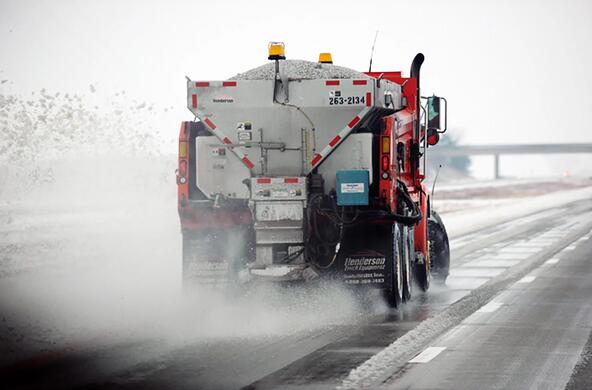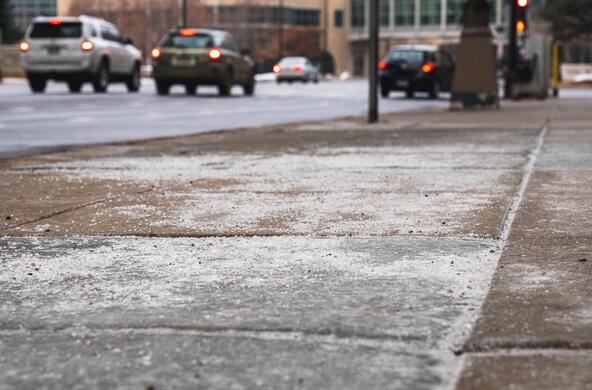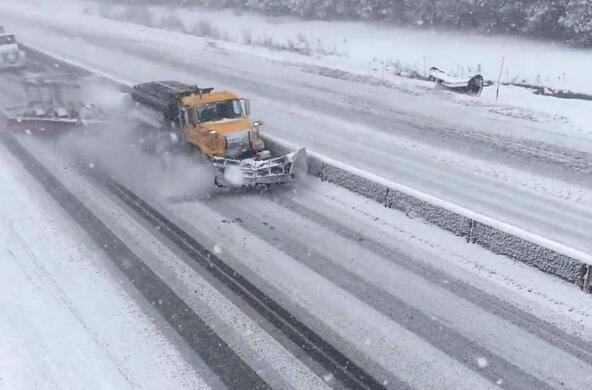Since the 1940s, salt has been used to keep winter roads free of ice and snow. It works by lowering the freezing point of water. In the U.S. alone, some 15 million tons of salt is applied to our roadways each year. While its use has real benefits, in terms of safety and navigation, there have been cumulative costs to the environment.
In this interview, Cary Institute Environmental Monitoring Program Manager Victoria Kelly and Freshwater Ecologist Dr. Stuart Findlay provide insight into the history of road salting, its impact on groundwater, and innovations in sustainable deicing.
Where does all the salt we put on roads come from? And where does it go?
Kelly: Deicing salt is simply unrefined table salt. We mine it from underground salt deposits, which were formed by ancient oceans, using drilling and blasting. The U.S. is one of the world's leading road salt producers, with New York alone mining more than 4 million tons a year.
Enormous quantities of salt are used to keep roads ice-free. In a typical New York winter, a half a million tons of salt is applied to our state’s roads. We’ve long known that salt corrodes vehicles and expensive infrastructure like bridges. But there is also a growing body of research that shows salt use is degrading freshwater resources.
Findlay: Road salt is not simply transported from roadways, to streams, to the ocean. Our long-term studies indicate it is retained in watersheds, where it accumulates. In some rivers and streams, peak salt levels have risen well above the federal level set to protect fish and amphibians (230 mg Cl/L). Even lower levels of exposure have negative effects on sensitive plants and animals if exposure times are long.
Kelly: We are also seeing persistent impacts in our groundwater. In Dutchess County, it’s not uncommon for private wells to have sodium concentrations that exceed government health standards. This is especially alarming for people with sodium restrictions.
Can we use less salt and stay safe?
Kelly: Anyone who has ever been stuck behind a salt truck knows that spreaders can be inefficient. Older equipment applies salt at a steady rate, regardless of vehicle speed or road conditions. Because salt bounces, a lot ends up on the roadside, where it does little to help drivers.
Management practices can reduce salt overuse. Some are as simple as calibrating equipment, not overfilling trucks, and
pre-wetting salt. There are also temperature sensors and application regulators that fine-tune the amount of salt applied. When the Town of East Fishkill retrofitted their trucks with this technology, they experienced real savings in their salt budget.
Findlay: Brine is another important deicing tool. Compared to rock salt, brine uses 60-70% less sodium chloride overall, and it doesn’t bounce. Applying it before a snow event prevents the ice-pavement bond from forming, making it easier to remove snow later on. Because brine is a liquid, it does require different spreading equipment, so there is an initial capital expense.
Are there feasible salt alternatives?
Kelly: Alternatives like calcium chloride cost about 5-6 times more than salt. Right now they are only economically feasible for vulnerable areas such as roads near reservoirs and municipal water supplies.
Findlay: From beet juice in Michigan to cheese brine in Wisconsin, novel deicers have gotten a lot of attention lately. One thing is clear – we really need to exercise best-management practices when applying salt, and invest in research on salt alternatives. It can take decades for road salt to flush out of a watershed, so the increased salt concentrations we see today will be with us even after its use has stopped.
Kelly: Together, homeowners, municipal managers, and private contractors can make a difference. For tips on minimizing salt impacts, I encourage people to look at our report Road Salt: Moving Toward the Solution.








